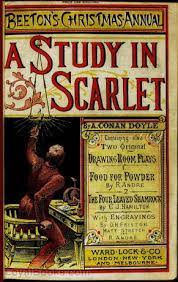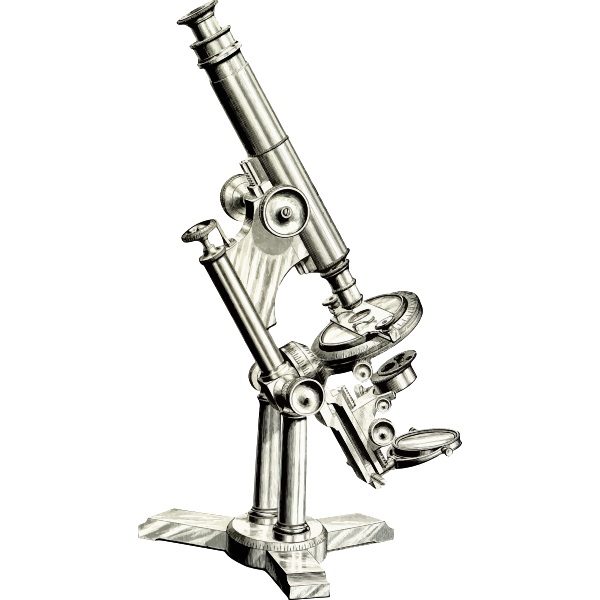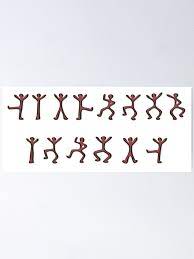Note: Spoiler alert. Since Sherlock uses forensics to solve the crimes in the stories featured in this blog, it isn’t easy to discuss these elements without, in some cases giving away the solution.
Sherlock Holmes drew his crime solutions from his observations and logical deductions. His use of forensics often backed up these conclusions. And while the forensics sited in the stories may be in their early stages of development, they added a fascinating feature.
Sherlock Holmes periodically references the various monographs he has written on particular forensic subjects in the stories. A monograph is a scholarly paper on a single topic for those unfamiliar with the term.
The analysis of fingerprints, serology (blood serum), ciphers, trace evidence, footprints, and even typewriters was mentioned by Arthur Conan Doyle long before the police force used them.
Arthur Conan Doyle credits much of Holmes’s knowledge and passion for forensics to his professor at Edinburgh College surgeon, Dr. Joseph Bell.
Let’s take a look at some of the forensics employed by Sherlock Holmes.
Blood Work
In the first Holmes story, Watson has returned from Afghanistan wounded and possessing limited funds. He runs into an old friend, Stamford, who indicates he might have a way to help him with his finances. Another acquaintance, Sherlock Holmes, is looking for a roommate to share expenses.
They meet Holmes in the St. Bartholomew Hospital lab, where he is working on a chemical experiment with hemoglobin that will help the police identify criminals through blood droplets.
“A man is suspected of a crime months perhaps after it has been committed. His linen or clothes are examined and brownish stains discovered upon them. Are they blood stains, or mud stains, or rust stains, or fruit stains, or what are they? That is the question which has puzzled many an expert., and why? Because there was no reliable test. Now we have the Sherlock Holmes test, and there will no longer be any difficulty.” A Study in Scarlet
Later in the story, Watson has moved in with Sherlock at Baker Street. He is reading an article about the science of Deduction and Analysis. The article states: 
“By a man’s fingernails, by his coat-sleeves, by his boot, by his trouser knees, by the callosities of his forefinger and thumb, by his expression, by his shirt-cuffs… a man’s calling is plainly revealed.”
Upon finishing the article, Watson remarks, “What ineffable twaddle!” I cried, slapping the magazine down on the table, “I never read such rubbish in my life.”
Holmes reveals he is the author of the piece.
Tobacco Ash
Sherlock is considered an expert in the study of cigar ash and wrote a monograph entitled Upon the Distinction Between the Ashes of the Various Tobaccos.
“I have made a special study of cigar ashes–in fact, I have written a monograph upon the subject. I flatter myself that I can distinguish at a glance the ash of any known brand either of cigar or of tobacco.” A Study in Scarlet
In “The Adventure of the Golden Pince-nez,” Holmes is called in by Scotland Yard to investigate the murder of Willoughby Smith, a young man working for the elderly bed-ridden Professor Coram. Upon arriving at the scene, Holmes first checks the path leading to and from the house for footprints. Holmes suspects the murderer may not have left the house.
After meeting Professor Coram, a chain smoker, Holmes begins smoking the professor’s specially prepared cigarettes from Alexandria. Holmes is smoking so many cigarettes that the professor comments Holmes smokes more than himself, and Watson questions Holmes’s actions.
“Have you a clue,” I asked at last.“It depends upon those cigarettes that I smoked,” said he. “It’s possible that I am utterly mistaken. The cigarettes will show me.”
 Later we learn that Holmes was smoking the cigarettes because he deliberately left a trail of ashes on the floor to help him determine where the killer was hiding.
Later we learn that Holmes was smoking the cigarettes because he deliberately left a trail of ashes on the floor to help him determine where the killer was hiding.
I, therefore, smoked a great number of those excellent cigarettes and dropped the ash all over the space in front of the suspected bookcase.
The Adventure of the Golden Pince-Nez
Footprints
In “The Boscombe Valley Mystery,” Holmes and Watson are summoned by Lestrade to Herefordshire. The murder of a wealthy landowner has occurred, and his son is the prime suspect. Holmes’s footprint analysis is the main factor for solving the case. The crime scene in the Sherlock spots Lestrade’s footprints and others. He can distinguish the differences between them and admonishes Lestrade for the condition of the crime scene.
That left foot of yours with its inward twist is all over the place… Oh, and how simple it would all have been had I been here before they came like a herd of buffalo and wallowed.
The Boscombe Valley Mystery
Another Holmes story that relies on footprints is “The Adventure of the Lion’s Mane.” In this story, Holmes shares with the reader that he has retired to Sussex and is spending time with a new friend, Harold Stackhouse. They are taking a walk when a young man approaches them from the lake, partially dressed with whiplash-type wounds on his back. Before they can help him, he dies, and Holmes is no longer retired but on the case.
 I walked slowly down the path. There was clay or soft marl mixed with chalk, and every here and there, I saw the same footstep, both ascending and descending. No one else had gone down to the beach by this track that morning.
I walked slowly down the path. There was clay or soft marl mixed with chalk, and every here and there, I saw the same footstep, both ascending and descending. No one else had gone down to the beach by this track that morning.
The Adventure of the Lion’s Mane
Holmes also published a monograph on tracing footprints, and it includes information on using plaster of Paris as a means to capture the impression before it is lost.
Handwriting
Note: The Adventure of the Reigate Squire, indicating the father, was also published as the Reigate Squires to include the son. Later, it was published as The Reigate Puzzle, Arthur Conan Doyle’s original working title.
There has been a longstanding dispute over ownership of estate lands between the Actons and the Cunninghams. While Holmes is resting at the estate of Colonel Hayter, a friend of Watson, he learns of a burglary at the nearby Acton estate. They also learn a butler, William Kirwan, is murdered at another estate. One clue is a torn piece of paper found in William’s hand.
“It is of the highest importance in the art of detection to be able to recognize, out of a number of facts, which are incidental and which vital. Otherwise, your energy and attention must be dissipated instead of being concentrated. Now, in this case, there was not the slightest doubt in my mind from the first that the key of the whole matter must be looked for in the scrap of paper in the dead man’s hand.”
By analyzing the note, Holmes determined it was written by two different men—one older and one younger.
You may not be aware that the deduction of a man’s age from his writing is one that has been brought to considerable accuracy by experts.
Holmes also deduces that other characteristics show that the two writers of the note are related.
There is something common between these hands. They belong to men who are blood relatives. It may be most obvious to you in the Greek e’s, but to me, there are several other points that indicate the same thing. I have no doubt at all that a family mannerism can be traced in these two specimens of writing.
The Reigate Puzzle
The commonality in the writing samples allows Holmes to solve the murder and the case.
Fingerprints
In “The Adventure of the Norwood Builder,” Holmes is engaged by John Hector McFarlane, a young lawyer. Jonas Oldacre, a builder, has contacted McFarlane to write a new will that makes him the sole beneficiary. He creates the document and then travels to his benefactor’s home with the papers. When he leaves the builder, he is alive and well.
The following day, McFarlane reads about the builder’s murder and the burning of his body. McFarlane realizes he is the prime suspect and asks Holmes to prove his innocence.
Holmes determines a wax seal from a document was covered with some of the builder’s blood and pressed onto the wall to incriminate McFarlane.
“But how in the world did you know that he was in the house at all?” The thumb-mark, Lestrade. You said it was final, and so it was, in a very different sense. I knew it had not been there the day before. I pay a good deal of attention to matters of detail, as you may have observed, and I had examined the hall and was sure the wall was clear. Therefore, it had been put on during the night.” The Adventure of the Norwood Builder
Equipment-Microscope
The “Adventure of Shoscombe Old Place” begins with Sherlock Holmes using a microscope to examine glue found on the cap next to a murdered policeman. The existence of the glue implicates a gentleman who makes picture frames.
Sherlock Holmes had been bending for a long time over a low-power microscope. Now he straightened himself up and looked around at me in triumph.“It is glue, Watson,” said he . . . “Those hairs are threads from a tweed coat. The irregular grey masses are dust. There are epithelial scales on the left. Those brown blobs in the centre are undoubtedly glue . . . Since I ran down that coiner by the zinc and copper fillings in the seam of his cuff, they [Scotland Yard] have begun to realize the importance of the microscope.”
There are epithelial scales on the left. Those brown blobs in the centre are undoubtedly glue . . . Since I ran down that coiner by the zinc and copper fillings in the seam of his cuff, they [Scotland Yard] have begun to realize the importance of the microscope.”
The Adventure of Shoscombe Old Place
However, the actual crime in this story is not solved by the microscope or other forensic evidence because there is little tangible evidence. Head trainer John Mason from Shoscombe Old Place, a racing stable in Berkshire, comes to Holmes about his master, Sir Robert Norberton. Mason thinks he has gone mad. Sir Robert’s sister, Lady Beatrice Falder, owns Shoscombe, but it will revert to her late husband’s brother when she dies.
The stable has a horse, Shoscombe Prince, who Sir Robert hopes will win the Derby. He would be out of debt before the transfer of the estate. This case is solved not by forensics but by a dog that does not recognize its owner.
Note: This is the last of the Sherlock Holmes short stories published only three years before Arthur Conan Doyle’s death. He’s buried with his second wife, Jean, in Minstead, Hampshire. The inscription on his gravestone reads: “Steel true, Blade Straight.”
Equipment-Typewriter
Miss Mary Sutherland asks Holmes and Watson to find her fiancé, Hosmer Angel. He has disappeared on the very morning of their wedding. Miss Sutherland, while she lives with her mother and her mother’s second husband, James Windibank, she supports herself with interest from an inheritance which she gives her mother and Windibank for her living expenses. Holmes notes that Miss Sutherland has received only typewritten letters from Angel with no signature. 
“It is a curious thing,” remarked Holmes. “that a typewriter has really quite as much individuality as a man’s handwriting. Unless they are quite new, no two of them write exactly alike. Some of the letters get more worn than others, and some wear only on one side… in every case there is some slurring over the ‘e,’ and a slight defection the tail of the ‘f.’ There are fourteen other characteristics to which I have alluded are there as well.”
A Case of Identity
It becomes evident that the letters from the suitor Mr. Hosmer Angel and the note from the stepfather James Windibank were all written on the same typewriter. Holmes comments during his disclosure that based on his intensive study of the typewriter; he had entertained writing a monograph on the subject.
Ciphers
I am fairly familiar with all forms of secret writings and am myself the author of a trifling monograph upon the subject, in which I analyze one hundred and sixty separate ciphers.
The Adventure of the Dancing Men
“The Adventure of the Dancing Men” begins when Holmes is sent a note from Mr. Hilton Cubitt, a simple country squire. The message contains a series of stick figures representing several letters and chalk drawings left for his American wife, Elsie. The notes frightened Elsie, but she does not share their meaning with her husband. Holmes takes on the case and breaks the code.
 For two hours, I watched him as he covered sheets after sheet of paper with figures and letters, so completely absorbed in his task that he had evidently forgotten my presence. Sometimes he was making progress and whistled and sang at his work; sometimes he was puzzled, and would sit for long spells with a furrowed brow and a vacant eye. Finally he sprang from his chair with a cry of satisfaction, and walked up and down the room rubbing his hands together.
For two hours, I watched him as he covered sheets after sheet of paper with figures and letters, so completely absorbed in his task that he had evidently forgotten my presence. Sometimes he was making progress and whistled and sang at his work; sometimes he was puzzled, and would sit for long spells with a furrowed brow and a vacant eye. Finally he sprang from his chair with a cry of satisfaction, and walked up and down the room rubbing his hands together.
Later Holmes explains how he broke the code and sent a message to a nearby farm to lure the criminal to the estate where murder and a shooting occurred.
“Having once recognized, however, that the symbols stood for letters, and having applied the rules which guide us in all forms of secret writings, the solution was easy enough…
As you are aware, E is the most common letter in the English alphabet, and it predominates to so marked an extent that even in a short sentence, one would expect to find it most often.
It occurred to me that if these appeals came, as I expected, from someone who had been intimate with the lady in her early life, a combination which contained two E’s with three letters between might very well stand for the name ‘ELSIE.’
The Science and Use of Forensics
In so many of the stories, Holmes uses multiple methods for solving the crime. It’s his observations that others often miss. Then Holmes takes the clues and applies the logic of deduction and forensics science. This combination of techniques allows him to put everything together to solve the crime.
“And the murderer?” Is a tall man, left-handed, limps with the right leg, wears thick-soled shooting boots and a gray cloak, smokes Indian cigars, uses a cigar holder, and carries a blunt pen-knife in his pocket.”
The Boscombe Valley Mystery
Dr. Watson sums up Sherlock’s forensics and science to solve crimes.
You have brought detection as near an exact science as it will ever be brought in this world.
A Study in Scarlett
